Looking to try Spotify promotion and not sure which services are worth it? I personally tried dozens of companies to see which ones got real results. Based on those campaigns, here are my top (legitimate) services:
- Members Media
- Indie Music Academy
- YouGrow Promo
- Two Story Media
- Playlist Push
- Moonstrive Media
- Daimoon Media
- Omari MC
- Playlist-Promotion
- SubmitHub
- Spin Promo
- SoundCampaign
- SubmitLink
- Groover
Each of the companies up there provided streams from real people, not bots. While results will vary, I’d consider each company above to be legit.
That said, the list is pretty subjective; my ninth-ranked company could’ve been the first-ranked company, and so on. Feel free to click through and check all of these services out for yourself. Also, heads-up that many of the links up there are affiliate links, which means that if you do click one of them and try a campaign, I’ll get a small commission.
I’m not going to lie – testing this many Spotify promotion services was a wild ride.
It was complete with some interesting ups and some pretty sad downs (yes, sadly, a couple of companies I tried were total scams). Over the rest of this post, I’m going to unpack everything I learned. I don’t usually provide a table of contents for my posts, but this one is long enough that some sort of outline is needed.
Here’s what I’ll be covering. (You can click any of these links to jump to the corresponding topic.)
- A data-driven look at how all 14 campaigns went (with charts I struggled hard to make in Canva)
- My list of the top Spotify promotion companies
- My list of companies you should avoid
- The place for Spotify playlisting (versus other forms of promotion)
- How these promotion services actually work (there are a few different models, and they impact what you should expect from your results)
- Interesting things I’ve learned from running dozens of campaigns
This will be kind of a lot.
If you’re thinking, “Yeah, this is starting to feel like a long-winded recipe blog post and I really just came here to pick a company that won’t scam me, not to read your life story,” then feel free to click a link above and skip to the part you’re most interested in.
But if you want to know my life story (and “life story” is just code for “things I’ve learned from running 15 campaigns,” not necessarily everything that’s happened to me since 1992), then thank you – and keep reading.
Let’s start with the numbers.
Spotify promotion services by the numbers
First up, here’s the data from each campaign that I ran.
An important note to keep in mind as you review these numbers is that each promotion ran with a different song from a different artist.
I’m not a data scientist or a doctor, and this isn’t an academic study where everything was perfectly controlled – kind of the opposite, actually. So don’t pay too much mind to minor variances. My goal here is to show the bigger picture, not necessarily to say which company is best on the basis of one campaign.
With that said, you can scroll through the spreadsheet below to see all of the numbers.
(And sorry… I couldn’t find a prettier way to embed the Google Sheet. That first column is frozen in the sheet itself, and there are some comments that aren’t showing, too. If you want to check it out for yourself in its natural state, here’s the link to view it in a new tab.)
Semi-important: I’ve put together a glossary of terms to make sure you take the right meaning from that spreadsheet.
Click here to read it (worthwhile if you want to dig into the data and actually understand what it means).
And once you’ve done that, let’s paint a couple of pictures with the data.
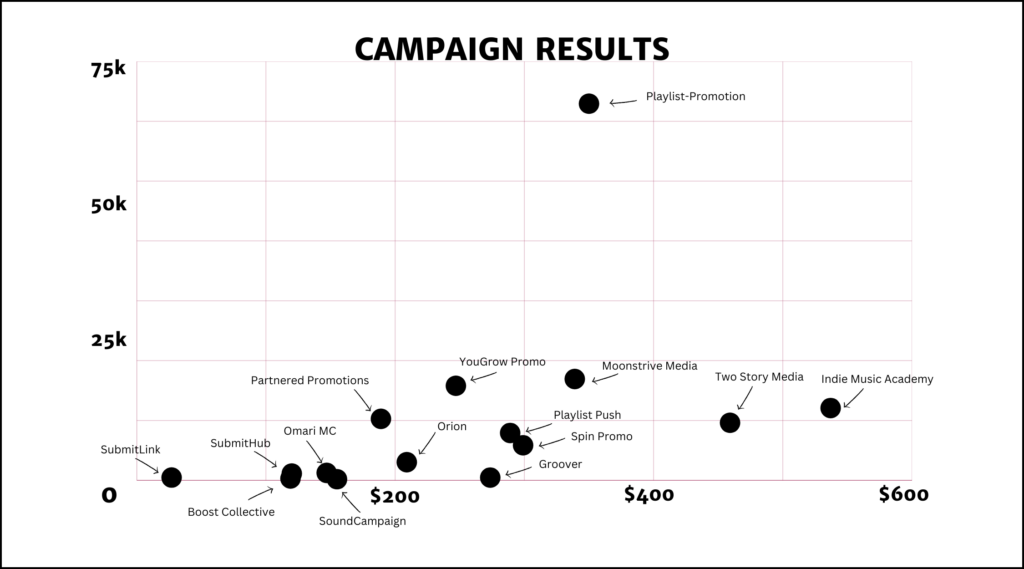
Interesting, right?
Admittedly, Playlist-Promotion’s 62,000-stream campaign (which I don’t view quite as favorably as you might think) kind of warps how the data appears; the first gridline on the Y-axis is at 25,000 streams, and no other company even came close to that mark. So even though Omari MC generated ten times as many streams as SoundCampaign (1,246 vs. 188), the two campaigns look like they share the same dot.
Let’s take a look at the same graph without the outlier of the Playlist-Promotion campaign.

You can kind of get a sense for the campaigns that really worked and the ones that really didn’t, and you can certainly see how they stack up in terms of gross cost.
Here’s a view that’s maybe even more helpful:
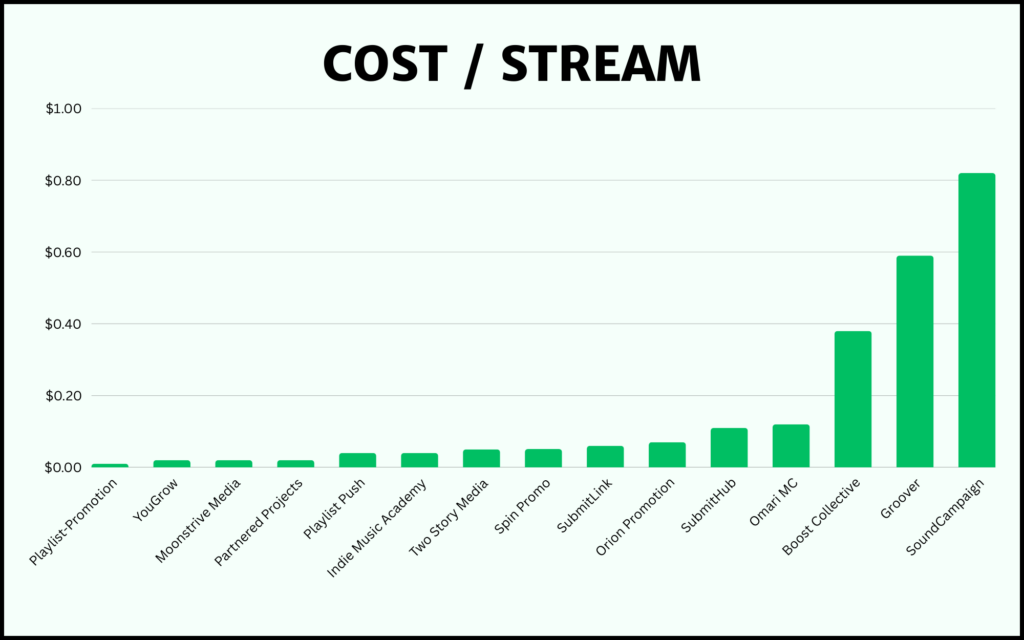
As I’ll get into shortly, even Cost Per Stream doesn’t tell the full story, because that number doesn’t take into account how relevant the streams are. You could have an incredibly low Cost Per Stream, but if it’s due to bots, it would actually be a negative thing.
But the chart does let you see which campaigns were inefficient. I think you could draw the line right after Omari MC – everything to the left of that was relatively affordable, and everything on the right of that probably wasn’t worth the spend (although as I’ll explain below, I think that because of the model they use, Groover and SoundCampaign actually have a pretty high upside).
All right, you’ve seen the data. Next up, here’s my list of the top companies.
The top Spotify promotion companies
Keep in mind, again, that this list is totally subjective. My first-ranked company may not be the best choice for you; I’d recommend clicking through and determining for yourself which option you think fits your goals. I obviously haven’t ranked these services by some simple metric like Cost Per Stream or Estimated Total Streams. Instead, I’ve just tried to go by how I feel about each service given my experiences, accounting for the fact that each campaign used a different song and that there are a few different promotional models in play.
Maybe a better way to explain my methodology: The following list reviews my overall perspective on each company, rather than offering some attempted ranking of each one-off campaign.
For each company, I’ve provided:
- A brief on the company as a whole
- Information on the service model they use
- A quick breakdown on how each campaign went
- A picture of campaign data (note that I’ve tried and occasionally failed to provide three month intervals and that the red box is where the campaign was active)
- A few pros and cons
I’ve also written standalone reviews of most of these services, in case you’re interested in learning more about a specific one.
Okay, enough said. First up:
1. Members Media
The brief on the company: These guys used to be called Partnered Projects, but recently rebranded (the campaign I tried with them reflects the old name). I actually hadn’t heard of them at all until early 2023, when Andrew Southworth told me that he was working with the group to run ad campaigns in tandem with playlisting campaigns. I’ve got a high opinion of Andrew, so I bookmarked these guys to check out. I ended up running a pretty successful campaign with them and having a good conversation with Dalton, the founder of the company.
From what I understand, the agency was originally launched by a marketing group geared toward larger-scale artists (think: major labels) rather than indie acts. Dalton showed me some of the bigger campaigns they’re running, and honestly, I came away impressed. But they’ve since expanded to offer services to indie artists, too.
The model they use: Done-for-you pitching to a closed network of playlists. You pay for placements. (See a breakdown of the different Spotify promotion models here.)
The brief on my campaign with Members Media: I got a free trial of a campaign that would’ve cost $189. It resulted in two playlist placements that generated 10,275 streams at a Cost Per Stream of $0.02. It’s hard to tell, but I think the true number of streams this campaign caused is much higher; the track was at around 3,000 streams after being out for a year, and after a month of playlisting, it reached 23,000 streams thanks to a bunch of non-credited playlist adds.
This campaign is too recent for me to show you a three-month timeframe, but here’s what it looks like in Spotify for Artists at the moment.
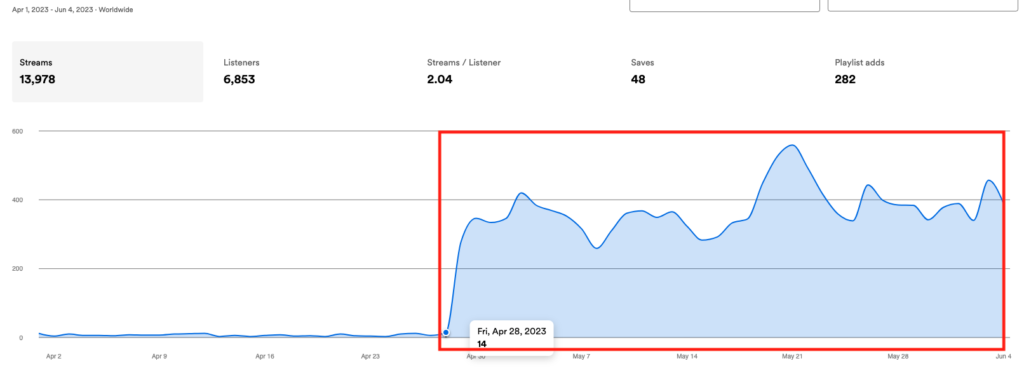
You can read my full review of the Members Media campaign here.
Pros of Members Media
- They’re affordable at a cost-per-stream level and in terms of total cost; packages start at around $50.
- You don’t pay until they’ve approved your song. I’m a big fan of that approach.
- They offer a minimum guaranteed number of streams. (They don’t promise specific lists, but they’ll pitch until they get enough placements.)
Cons of Members Media
- They reject a lot of songs. (They rejected the first song I tried to send them.) This isn’t really a con in terms of results, to be fair, because it ensures they’re only working with artists they can help. But it’s a con for your chances of working with them.
- I don’t want to generalize this, because things vary from campaign to campaign, but I do want to note that the algorithmic traction from my trial campaign has been lower than I’d expected.
The bottom line: If you get accepted by this company, you’ll get to work with a team that has a ton of Spotify marketing experience. These guys are legit. If you want to give them a shot, here’s the button:
2. Indie Music Academy
The brief on the company: Ryan Waczek (the founder of IMA) works really hard to generate high-engagement playlist placements and maintain an above-average hair aesthetic. His hard work shows in his results in both areas.
One thing I really appreciate about Indie Music Academy is the company’s clear communication about their process and philosophy. Click through to many of the other sites listed here, and even though they may do good work, a lot of them don’t communicate very well about how they do it. Often, it’s hard to determine what’s real and what’s just jargon. Ryan’s white paper on his company’s approach to playlisting, on the other hand, represents the opposite. It’s one of the best examples of clear thinking and transparency that I’ve seen in this space.
The model they use: Done-for-you pitching to a closed network of SEO-built playlists. You pay for placements. (See a breakdown of the different Spotify promotion models here.)
The brief on my campaign with Indie Music Academy: I trialed a $537 campaign that generated 12,079 streams from three highly-engaged playlists for a Cost Per Stream of $0.04. Outside of credited placements, attribution is difficult, but this was an artist that started from near-scratch and ended up with 31,000 real streams in the month after the campaign. I think it’s likely that nearly all of those resulted from IMA’s work.
Here’s what it looked like in Spotify for Artists.
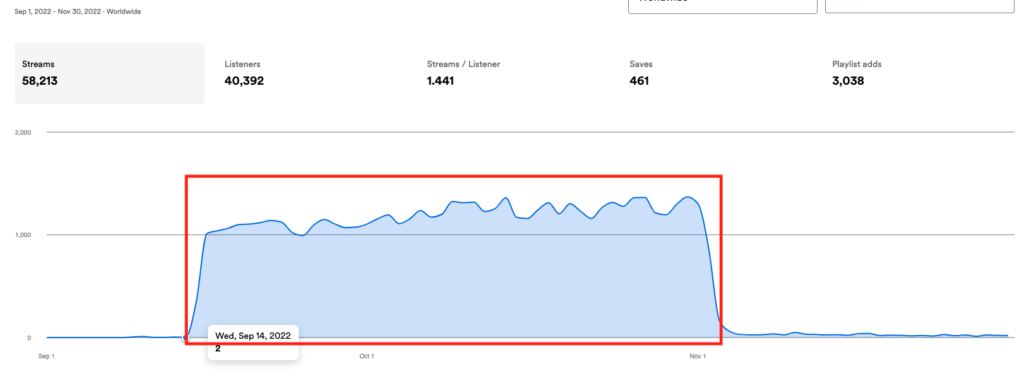
You can read my full review of an Indie Music Academy campaign here.
Pros of Indie Music Academy
- They place you on highly engaged, healthy playlists.
- They’re relatively affordable on a cost-per-stream basis.
- They’re very transparent and I like the way they think about playlisting.
- They offer a guaranteed number of streams, so any money you spend will definitely get results. (They don’t promise specific placements, they just offer a refund if they don’t hit their campaign target.)
Cons of Indie Music Academy
- SEO-based playlists are less likely to be high-fit in terms of genre.
- While they do relatively well at a cost-per-stream level, they’re expensive in terms of total cost; their entry package starts at $297.
The bottom line: If you’re looking to build streaming numbers via playlisting and want to make sure you really are getting organic numbers, Indie Music Academy is a top option, and Ryan’s a solid guy. If you’re interested, you can…
3. YouGrow
The brief on the company: YouGrow’s kind of a do-it-all agency; in addition to their Spotify playlisting, they also offer TikTok promotion (which I’ve reviewed here), YouTube promotion (which I’ve reviewed in brief here), and Instagram influencer promotion (which I’ve reviewed here). I’d consider all of their services to be legitimate, but honestly, their Spotify promotion is my favorite thing they offer.
They’re good at it.
I’ve run multiple Spotify campaigns with them and have seen consistently solid results. Their playlists are engaged, and while they don’t specifically say that they target SEO-built playlists, the vast majority of the placements I’ve gotten with them have shown well in Spotify search.
Also, I’ve talked to a bunch of people at the company and they’ve all been nice. So that’s a point in their favor.
The model they use: Done-for-you pitching to a closed network of playlists. You pay for placements. (See a breakdown of the different Spotify promotion models here.)
The brief on my campaign with YouGrow: I’ve run a bunch of campaigns with these guys, but my most recent cost $247 and generated 15,797 streams across two playlists at a Cost Per Stream of $0.02. This artist had some streaming traction already, but the campaign provided a nice bump that hasn’t yet died down. A plus was that the playlists were decent fits for the genre of the song.
Here’s what it looked like in Spotify for Artists.
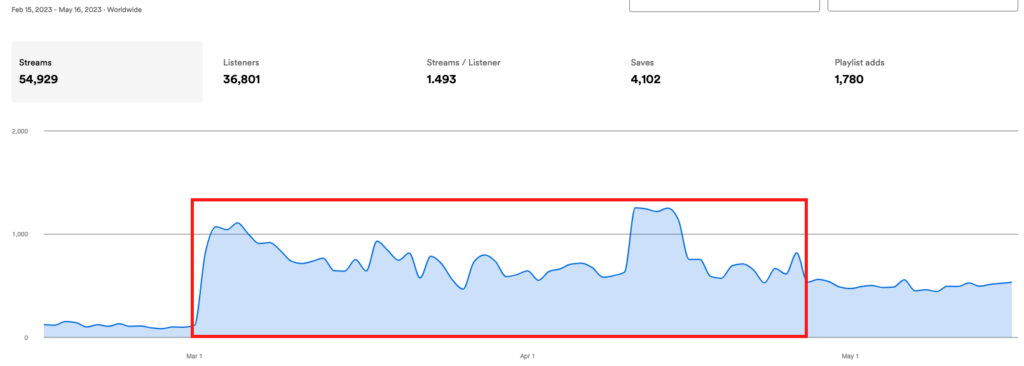
You can read my full review of the YouGrow Promo campaign here.
Pros of YouGrow
- YouGrow is one of the most affordable options on a cost-per-stream basis and one of the more affordable options in terms of total cost; their packages start at just $77.
- Their playlist network seems to be healthy and engaged – while they don’t claim to focus on SEO-built playlists, all the lists I’ve seen are performing well in Spotify search.
- They offer guaranteed streams. (They don’t guarantee specific placements, but they’ll pitch your music until they get results.)
- Apparently they plant trees when you buy from them. I like trees.
Cons of YouGrow
- The top location for the song we promoted ended up being Brazil. If you’re fine with international streams, that’s not really a con. But if you’re focused on so-called “Tier 1” countries, it might be.
- Their campaigns have resulted in streams-per-listener numbers that are lower than I’d ideally like to see. It’s not at a worrisome level, but it could be improved.
The bottom line: I’d consider YouGrow Promo to be a great option if you’re a playlisting newbie. They don’t have the ceiling of Playlist Push and their playlist network isn’t my absolute favorite, but their lists are healthy and you don’t have to spend all that much to get a nice return of guaranteed results. If you’re so inclined…
4. Two Story Media
The brief on the company: Fair warning to start off – this is my company, so I am obviously super biased and you should take everything I write below with a grain of salt.
With that said… personally, I think we’re great, and my mom agrees.
Also, we’re markedly different than any of the other playlisting services on this list in that we don’t pitch your music to a network of curators at all. Instead, we run Meta ads to playlists that artists create themselves.
I actually had the idea for this sort of service after doing the bulk of the research for this post. Having tried a bunch of other campaigns where I’d had music pitched to curators, I thought to myself, “Huh, wouldn’t it be nice if I were the curator?”
The advantages of being your own curator are pretty straightforward. First, rather than seeing your streams spike back down after a campaign, you can keep your music on your own playlist for as long as you’d like. Second, you also get to ensure that you’re on a playlist that’s an absolute perfect fit your music. Third, you can add multiple songs to your playlist, so you can spread your promo around your catalog more easily.
The drawback to this approach is that it tends not to be quite as cost-effective as working with the biggest playlist networks; those services have already done the work of building hugely popular playlists, after all. But the longer-term benefits are pretty appealing.
The model they use: Building a popular playlist for you with Meta ads. (See a breakdown of the different Spotify promotion models here.)
The brief on my campaign with Two Story Media: I demoed this method for my own track, “Everything,” building a playlist called “Chill Worship” that cost $459 and drove 9,622 for a Cost Per Stream of $0.05. Engagement was slightly higher than I’ve seen for most other playlisting services, and streams keep coming in over time (because I’m not taking my song off of my own playlist, clearly).
Here’s what it looked like in Spotify for Artists.
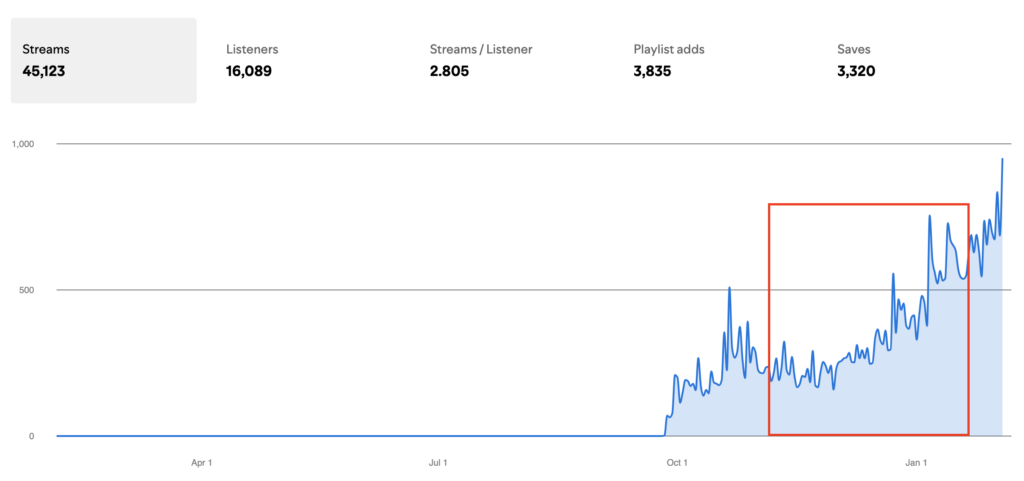
You can see a video breakdown of how the campaign went here.
Pros of Two Story Media
- You own your own popular playlist, which is a nice ego boost
- Longer-term streaming results, since, again, you own the playlist and don’t need to ever remove your songs
- The playlist is guaranteed to be a perfect fit for your music, which tends to lead to slightly higher engagement rates (although playlists still tend to be passive listening experiences)
- You can add multiple songs to your playlist, so it’s easy to spread your promo across your catalogue
- My mom thinks they’re great
Cons of Two Story Media
- It’s slightly more costly on a cost-per-stream basis than the big playlist networks, especially in the shorter term.
- It takes a little more work to build your own playlist.
The bottom line: I honestly think this is a great option for taking advantage of the power of playlisting while minimizing some of the tactic’s drawbacks. It’s legitimately effective and it works over the longer-term, which is why I use it for my own music. But – one more time – I am heavily biased, since this is my company. That said, if you’re so inclined…
5. Playlist Push
The brief on the company: Playlist Push has, in my experience, the highest ceiling of any of the Spotify curator submission platforms. The reason is that they pay curators more than competitors like SubmitHub, so they’re able to attract bigger playlists – and, unlike models that offer guaranteed streams, they won’t stop pitching when they reach their promised threshold. I’ve run two campaigns with them that have generated literally zero placements, but when a campaign does do well, it has the potential to do very well.
On a semi-related note, I’ve run multiple campaigns with this company that have coincided with an increase algorithmic activity. I think this is because, in general, Playlist Push does a pretty good job of generating high-fit playlist placements.
The model they use: Done-for-you pitching to an open network of Spotify curators. You pay to submit to curators. (See a breakdown of the different Spotify promotion models here.)
The brief on my campaign with Playlist Push: My most recent campaign with these guys cost $289 and drove 7,915 streams across 13 playlists for a Cost Per Stream of $0.04. It was for an artist that already had some streaming traction, which makes it tougher to determine attribution, but we did see some Discover Weekly streams come in shortly after running the campaign.
Here’s what it looked like in Spotify for Artists.

You can read my full review of an earlier Playlist Push campaign here.
Pros of Playlist Push
- I think they probably have the highest ceiling out of any company on this list.
- In my experience, they tend to get high-fit placements.
- I’ve seen multiple campaigns with this company that have correlated to longer-term algorithmic growth.
Cons of Playlist Push
- They offer no guarantee. The good side of this is that they don’t cap results at a certain threshold, but the downside is that you could spend $300 or more and get literally nothing back.
- While you can see feedback, you have limited ability to interact with curators – unlike on SubmitHub or SoundCampaign, you can’t chat with them, so it’s harder to establish relationships.
The bottom line: Playlist Push doesn’t guarantee any results, but they just might have the highest ceiling out of any company on this list. If you’ve never tried playlisting before, you may want to start with a lower-stakes spend (like SubmitHub or a model where a return is guaranteed).
But if you’re highly confident that your song will do well via playlisting, Playlist Push can give you a ton of bang for your buck. If you want to give it a shot, use code CXUFDQ2 and you’ll get 7.5% off your first campaign.
6. Moonstrive Media
The brief on the company: Moonstrive Media is one of the newer players in the Spotify promotion space (they’ve only been offering their service under this brandname for a couple of years), but that fact belies their experience. As Janik from the company told me, the team at Moonstrive has actually been resold by other playlisting companies for a while, thanks to the strength of their SEO-based playlist network.
And that’s the key value these guys offer: Moonstrive exclusively provides placements on SEO-built playlists. Other companies on this list blur that SEO line a bit, but in talking with Janik, it’s clear that he genuinely believes in the value of it as a playlisting approach. I respect that – and I’ve seen it work.
The model they use: Done-for-you pitching to a closed network of SEO-built playlists. You pay for placements. (See a breakdown of the different models here.)
The brief on my campaign with Moonstrive Media: I got a free trial of a package that would’ve cost $339. It resulted in 16,934 streams across 10 playlists for a Cost Per Stream of $0.02. While not all of the playlists were as targeted genre-wise as I would’ve liked, they were all healthy and solidly engaged, and they all ranked in Spotify search results.
Here’s what it looked like in Spotify for Artists.
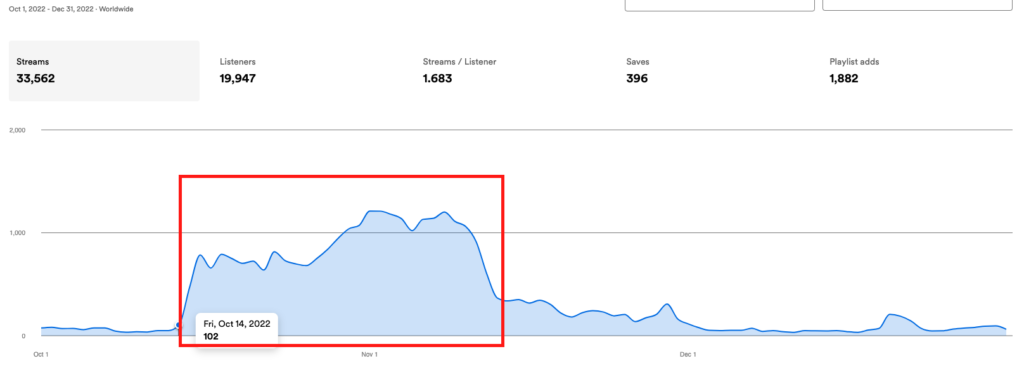
You can read my full review of the Moonstrive Media campaign here.
Pros of Moonstrive Media
- Their SEO-built lists are healthy and highly engaged.
- They’re affordable on a cost-per-stream basis and on a total cost basis. (Packages start at $134.)
- They guarantee you’ll get on playlists that have a certain total number of followers. (They don’t guarantee specific placements.)
Cons of Moonstrive Media
- SEO-built playlists tend to be less-targeted toward specific genres.
- They’re not the best at communicating about their work ha. Janik admitted that he thinks this is the biggest challenge they’re facing; he thinks their results compare favorable to anyone, but said that they’ve always struggled to market themselves effectively.
The bottom line: I like that Janik and his team stick to their guns in targeting SEO-built playlists. While I think the approach has its drawbacks, I also think it’s a good way to ensure that playlists are healthy. All in all, Moonstrive Media is a solid option. Here’s the button to check them out:
7. Daimoon Media
The brief on the company: Daimoon Media is a company that doesn’t feature the words “grow” or “playlist” or “promotion” in their name, which, in this space, is a bold move. Don’t worry, though. Daimoon Media does offer playlist pitching (in addition to YouTube promotion and Soundcloud promotion). And, based on my experience, they do it well.
I tend to think that they’re best at working with more mainstream genres – think pop, EDM, hip hop, or rock – and they’re probably the best fit for artists who are looking to build an international audience. But if those two qualifiers describe you, then they’re worth checking out.
The model they use: Done-for-you pitching to a closed network of playlists. You pay for placements. (See a breakdown of the different models here.)
The brief on my campaign with Daimoon Media: I’m actually in progress with my latest campaign, so these stats will probably be updated over the next month or so. But, after about a month of run-time, the campaign has generated 8,887 streams from three playlists for a Cost Per Stream of $0.03.
Here’s what it looked like in Spotify for Artists.

Again, the plan is to update with more details pending the completion of my most recent campaign. But for now, you can read my review of a previous campaign with Daimoon here.
Pros of Daimoon Media
- While they don’t specifically target SEO-built lists, many of their playlists do perform well in Spotify search results.
- Relatedly, all the lists I’ve seen from them are healthy and engaged.
- They have affordable entry-level packages (the lowest starts at $57).
Cons of Daimoon Media
- As with other SEO-focused companies, they don’t always generate the highest-fit placements in terms of genre.
- They drive a high proportion of international streams. My most recent campaign drove the most traffic from Mexico. (This isn’t a con if you’re building an international audience, obviously.)
- I had a weird payment issue with them where their system wouldn’t process my credit card. I talked to Tom, the founder, and he said that happens to less than 1% of customers due to the system they use. Their team ended up taking payment via invoice, so it worked out, but I figured I’d note it.
The bottom line: Daimoon Media is another company that has a solid network of mostly SEO-built, healthy lists. If you’re in a mainstream genre and are interested in generating international traction, they’re a solid option. Hit the button if you’re interested in giving them a spin.
8. Omari MC
The brief on the company: You may be familiar with Omari if you’ve ever used the internet – the guy is everywhere online, and it’s not an accident. Omari’s one of the playlisting OGs. Actually, his was the first Spotify promotion service I ever tried, back when I was convinced I could rap and play the ukulele. (I’ve since discovered I can do neither.)
I’ve talked to Omari a few times over Zoom, and I’ve always come away impressed by his wide range of music marketing knowledge. His team works on pretty much every marketing channel under the sun, and they work with an impressive volume of clients each month. There’s no denying that they know their stuff.
The model they use: Done-for-you pitching to an open network of playlists. You pay for placements. (See a breakdown of the different models here.)
The brief on my campaign with Omari MC: My most recent campaign with Omari cost $147 and resulted in 11 playlist placements and 1,246 streams for a Cost Per Stream of $0.12. That’s on the higher end of the spectrum, especially for closed-network companies that promise some level of results. Engagement rates were a little below average, too, but the playlists were legitimate.
Here’s what it looked like in Spotify for Artists.
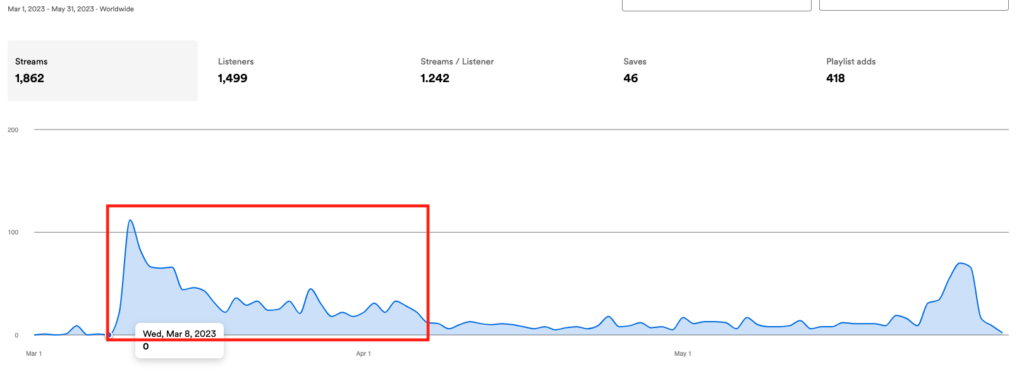
You can read my review of an earlier campaign with Omari MC here.
Pros of Omari MC
- One of the OGs in this space. This company has run a ton of campaigns; they know what they’re doing.
- I feel like Omari pretty much coined the term “organic streams” ha, and it’s fair to say that his playlists are healthy and not built with bots.
- They’re relatively affordable to get started with; their entry-level package is $77.
Cons of Omari MC
- Results will vary, but my last three campaigns with Omari have generated comparably high costs per stream. None of them has crested 5,000 streams, either.
- They don’t accept “explicit” songs. Honestly, I don’t think this is a con (I respect that Omari sticks to what he believes) but if you’re making explicit music, it’s a con for your chances of working with the company.
The bottom line: I don’t mean this in an offensive way ha – I consider Omari MC to be like the Walmart of Spotify promotion. They’ve been around for a while, they’re not particularly exciting, they offer a little bit of everything to a lot of people, and the quality maybe isn’t what you’d get if you spent twice as much.
But also, you know exactly what you’re going to get.
If you’re thinking about trying promotion for the first time and want something low-risk, these guys are a good option.
9. Playlist-Promotion
The brief on the company: If you looked at the graphics up there, you probably noticed that Playlist-Promotion drove an absurd amount of streams (about 62,000, which was far and away the most from any campaign). They focus mainly on SEO-built lists and there’s no denying that they can get super impressive results – but also, some context is necessary.
The model they use: Done-for-you pitching to an open network of playlists. You pay for placements. (See a breakdown of the different models here.)
The brief on my campaign with Playlist-Promotion: The company offered me a free trial of their “100K follower reach” package, which would normally have cost $350. The campaign resulted in 23 playlist placements that drove 62,939 streams at a Cost Per Stream of $0.01. Again, this was by far the most affordable campaign on a per-stream level, and it was also by far the most streams I saw from any campaign.
So yeah… it worked.
But I’m also pretty convinced that the results my campaign received aren’t representative of what artists should expect, on average, from this company.
Here’s why: The package I trialed promises 3-10 playlist placements with an estimated delivery of 8,000 to 20,000 streams – yet our song was placed on 23 playlists totaling 1.5M followers. Typically, the agencies that work on this model cap a campaign when it reaches the right number of playlists, but these guys provided an incredible surplus on expected delivery. And I think it’s because the company knew I’d be writing a review of the experience. I don’t blame them for proving their chops, but I’m also doubtful that my experience was normal.
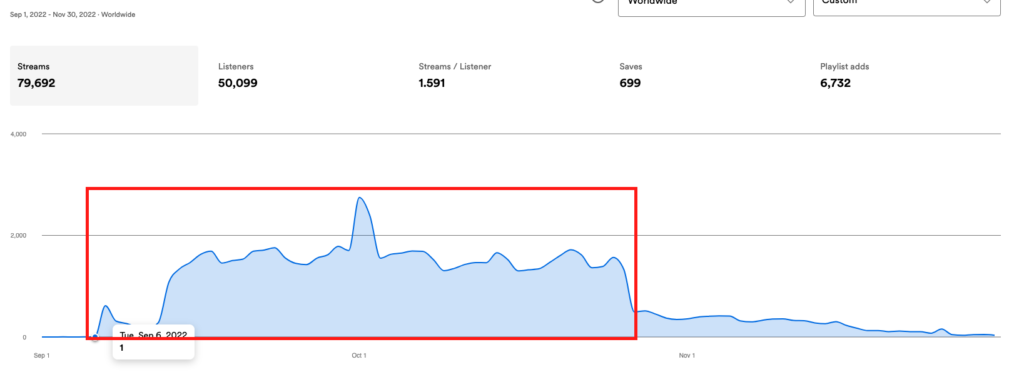
Make of it what you will. One thing you can’t deny is that these guys have big playlists that can drive an impressive amount of streams.
You can read my full review of the Playlist-Promotion campaign here.
Pros of Playlist-Promotion
- As I said, there’s no denying these guys have very active playlists. All the lists looked healthy, too.
- On a related note, this company provided the most streams I’ve ever directly received from a playlisting campaign. Respect.
Cons of Playlist-Promotion
- As mentioned several times in this post, big SEO-based playlists tend not to be the tightest genre fits.
- Maybe this shouldn’t be a con, but the campaign was almost too good. While these guys certainly have the capability to deliver, I want to note that you probably shouldn’t expect the same results that I received.
The bottom line: While I don’t think my incredible results from Playlist-Promotion are typical, there’s no denying that these guys have the capability to provide high numbers of streams from healthy playlists. With campaigns starting at $250, they’re on the higher-priced side of the spectrum, but they certainly have the firepower to back that up. If you want to check them out…
10. SubmitHub
The brief on the company: I’ve got SubmitHub down here at number 10, but they’re number one in my heart. If you’re just getting started with Spotify playlisting, this is probably the first company I’d try.
That said, these guys are much more than a Spotify promotion company; they’re what I think of as a “music submission platform.” You pay for credits that guarantee curators will listen to your music, allowing you to get blog write-ups, influencer placements, and a bunch of other stuff. (Relatedly, as of 2023, I consider SubmitHub the gold standard for indie press campaigns.)
On the Spotify side of things, specifically, they boast a large network of about 800 curators, most of whom run highly targeted playlists rather than big, SEO-built lists. That’s by design – Jason Grishkoff, the founder, believes that the point of playlisting should be to train Spotify’s algorithm with moderate numbers of targeted listens, rather than to generate big spikes in streams from a broader audience and risk muddying your data.
The model they use: Do-it-yourself pitching to an open network of Spotify curators – although Jason wants me to tell you that you can also hit a button to make it more of a done-for-you experience. You pay to submit to curators. (See a breakdown of the different models here.)
The brief on my campaign with SubmitHub: I’ve run a ton of campaigns on SubmitHub; some have worked really well and some have generated next to nothing. But the campaign I’ve listed on the spreadsheet above cost $120 and resulted in nine playlist placements and 1,130 streams for a Cost Per Stream of $0.11.
And because I got to hand-select each curator and playlist that I pitched, each of those nine placements was a very relevant genre fit.
Here’s what it looked like in Spotify for Artists.
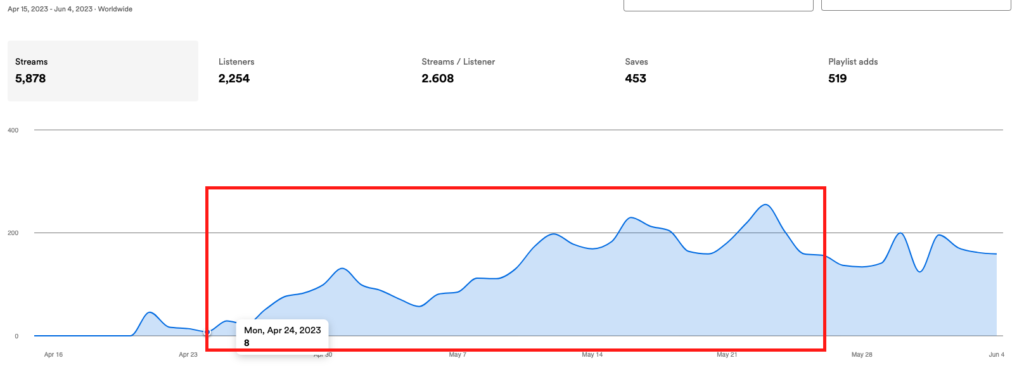
You can read our full review of SubmitHub here.
Pros of SubmitHub
- I think this platform is probably the single best way to target high-genre-match playlist placements.
- It’s really affordable to get started with SubmitHub. Jason recommends trying a small sample of curators to test whether your song will resonate before jumping into a bigger spend, which means that, for like $20, you can start to see results.
- I think this is probably the most transparent playlist pitching platform in the world. Everything you’d care to see about a curator is on display.
Cons of SubmitHub
- The biggest knock against SubmitHub is that the curators with the biggest playlists tend to gravitate toward other platforms, because SubmitHub doesn’t pay as much per review as some of the other networks on this list. That means it’s very rare to see a campaign that results in tens of thousands of streams.
- It’s a little more time-consuming to pitch on SubmitHub than it is to pay a done-for-you pitching service. (But if you care about genre-fit, it’s worth the little bit of extra effort.)
The bottom line: This is probably the best company to get started with if you’ve never done playlist pitching before. It’s also probably the best playlist pitching platform for training Spotify on the genre of your music.
That’s because campaigns start at super-affordable costs, and you can choose to target only the lists on which you want to be included. Moral of the story: If you can stand to hear some tone-deaf feedback from curators, there’s really no reason not to give SubmitHub a shot.
11. Spin Promo
The brief on the company: I first heard about Spin Promo when I started getting emails from Matt, their founder. Over the course of a couple of months on their email list, I came away convinced: These guys are really good at email marketing, and I wanted to pay them money.
Part of the appeal was that, on the service model side of things, the company advertises an interesting tactic: Spotify ads retargeting playlist listeners. Here’s how they put it: “Run native Spotify ads to retarget your biggest listeners, based on live playlist audience data.”
The upshot is that they get you playlist placements and then do a bit of work to translate those placements into longer-term engagement. Pretty cool-sounding idea, right? I thought so, at least.
The model they use: Done-for-you pitching to an open network of Spotify curators. (See a breakdown of the different models here.)
The brief on my campaign with Spin Promo: I ran a $299 campaign and saw my song placed on two playlists that drove a total of 5,862 streams for a Cost Per Stream of $0.05.
Here’s what it looked like in Spotify for Artists.
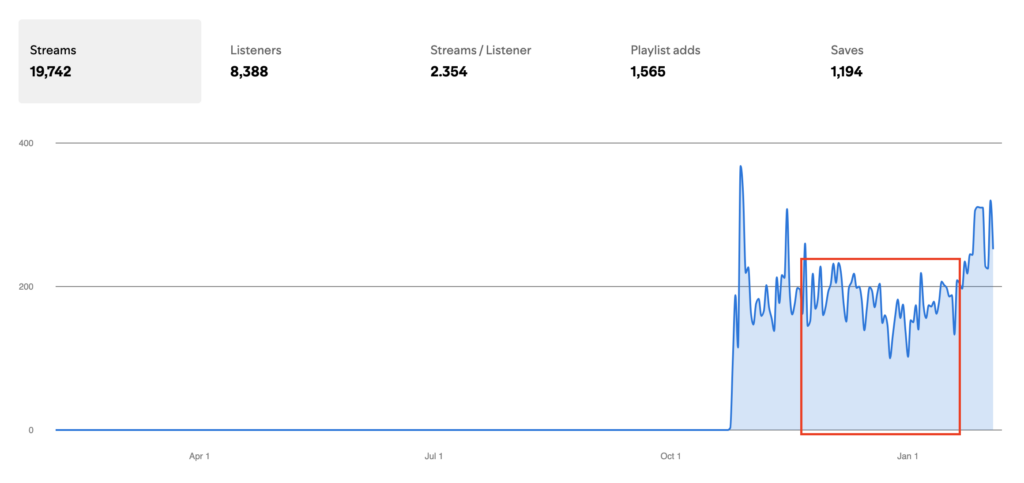
You can read my full review of Spin Promo here.
Pros of Spin Promo
- As a concept, I thought the retargeting thing was really cool.
- The playlists they added the track to were legit – good follower growth, good engagement, and a healthy number of streams.
Cons of Spin Promo
- Honestly, I was disappointed in the actual results of the retargeting. I just couldn’t see any sort of impact in the data. My hypothesis, as I wrote in my review is that Spotify ads just aren’t a super effective tactic, even though the idea is cool in principle.
- I was also slightly underwhelmed by their customer service. They don’t have a portal to track results (as of this writing, at least), and while they offered to respond for support by email, I didn’t hear back from them after a reach out.
The bottom line: I think these guys are legitimate, but I also think they’re still working out some of the kinks in their business model. The idea of retargeting is really appealing, although it didn’t translate to notable results in reality. I’ve got them penciled in to try in the near future. In the meantime, they do have some engaged playlists… and again, their email marketing is on point.
If you want to give them a shot…
12. SoundCampaign
The brief on the company: SoundCampaign is an up-and-coming playlist pitching company built on the open network concept.
I hadn’t heard of them before 2022, but I’ve heard a fair bit of hype on them more recently, so I decided to give them a spin as part of my experiment. Nadav, the founder of the company, has reached out to me a couple of times, but we haven’t been able to connect yet. From what I’ve seen from the outside and as a customer, though, I like their approach.
While I don’t have them in the top half of the list at the moment, this is a company I think is probably worth watching over the next few years.
The model they use: Done-for-you pitching to an open network of Spotify curators. You pay to submit to curators. (See a breakdown of the different models here.)
The brief on my campaign with SoundCampaign: I spent $188 on SoundCampaign to target an estimated 21 curators. That yielded two playlist placements that drove 188 streams for a Cost Per Stream of $0.82 (which was the highest Cost Per Stream out of all of the companies I tried).
Here’s what it looked like in Spotify for Artists.
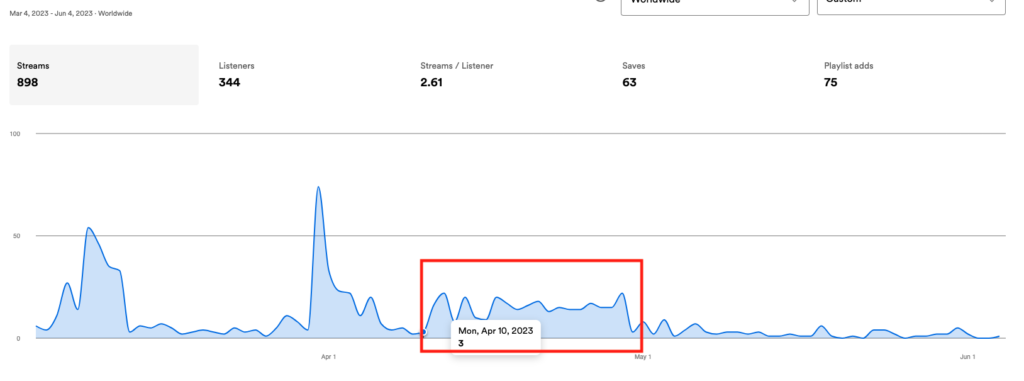
The results were mediocre, but I think this company has potential because their model is strong. You can see my full review of the SoundCampaign experience here.
Pros of SoundCampaign
- Their playlists appear to be legit – healthy and built with real listeners.
- There’s the potential to hit a homerun with this playlisting model.
- I like that you can respond to curator feedback on this platform. It’s a nice step toward more meaningful relationships.
Cons of SoundCampaign
- I don’t think my mediocre results should be taken as some overarching verdict on the platform, because things vary wildly from song to song – but still, my results were quite mediocre, so that’s got to be a con.
The bottom line: As with other open-network platforms, SoundCampaign offers the chance to hit a homerun with a playlisting campaign, since they (ostensibly) won’t cap your pitches once you hit a certain number of placements. Because my own campaign results were mediocre, I have a hard time ranking them alongside industry heavyweights like Playlist Push. But still, I like this company, and I think they’re worth keeping an eye on. If you want to trial them yourself, here’s the link:
13. SubmitLink
The brief on the company: If SoundCampaign and Orion Promotion are challengers to Playlist Push, then SubmitLink is a challenger to SubmitHub. Think of it as SubmitHub Lite, but geared specifically toward Spotify playlist curators. As on SubmitHub, you pay for credits and get to handpick which curators you want to send your music to, with the guarantee that they’ll listen and respond.
While it’s not a big player in the space yet, I’m a fan of SubmitLink, partly because I’ve talked to Aaron, the founder at the company, and appreciate his ethos. Like Jason at SubmitHub, it’s clear that Aaron is working on this as a labor of love. He’s constantly making improvements and soliciting feedback, and it shows in the growth of the platform over the past several years.
The model they use: Do-it-yourself pitching to an open network of Spotify curators. You pay to submit to curators. (See a breakdown of the different models here.)
The brief on my campaign with SubmitLink: This was my cheapest campaign in terms of total cost; I paid $27 and received two playlist placements that brought in 467 streams at a Cost Per Stream of $0.06. We got a decent bump in algorithmic traction after the campaign, too.
Here’s what it looked like in Spotify for Artists.
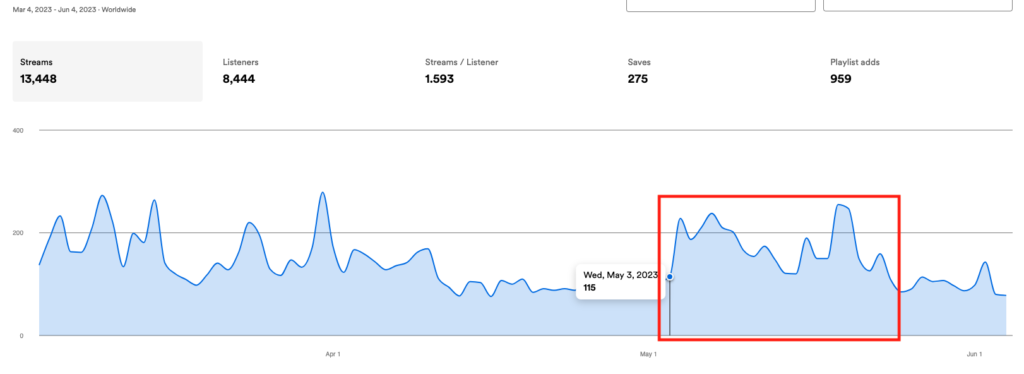
Pros of SubmitLink
- Like with SubmitHub, you can handpick which curators you pitch, so you can ensure you get high-genre-match placements.
- It’s super affordable to get started – my campaign cost $27.
- This is a very transparent platform; you get a lot of detail on the curators and playlists.
Cons of SubmitLink
- The biggest con is that SubmitLink’s curator network just isn’t that big yet. You can only pitch so many people here, and there aren’t as many niche genre fits as there are on SubmitHub. But the platform is growing, so this is becoming less of a weakness over time.
The bottom line: This is another great option if you’re getting started with playlisting, because you don’t have to pay much and you get to handpick the curators to which you’re pitched, so the risk of bad data is low. Consider using this as a complement to a SubmitHub campaign; spend $20 on both platforms and you’ll still come out below what you’d spend with most other companies on this list.
14. Groover
The brief on the company: Groover is another music submission platform where you can purchase credits to submit your song to blogs, playlist curators, and music industry professionals. Two Euros will get you two credits, which are good for one submission. The company was founded in 2018, and they’ve grown rapidly since then, with an especially impressive presence of curators in Europe.
As with SubmitHub, I was initially hesitant to qualify Groover as a service, seeing as they operate on a similar credit-based model. But, as before, I’ve decided to screw the semantics.
The model they use: Do-it-yourself pitching to an open network of Spotify curators – although you can also use pre-sets that make it more of a done-for-you experience. You pay to submit to curators. (See a breakdown of the different models here.)
The brief on my campaign with Groover: I’ve run several campaigns with Groover, but my most recent campaign cost $273.59 and resulted in 18 playlist placements and 460 streams for a Cost Per Stream of $0.59.
Here’s what it looked like in Spotify for Artists.
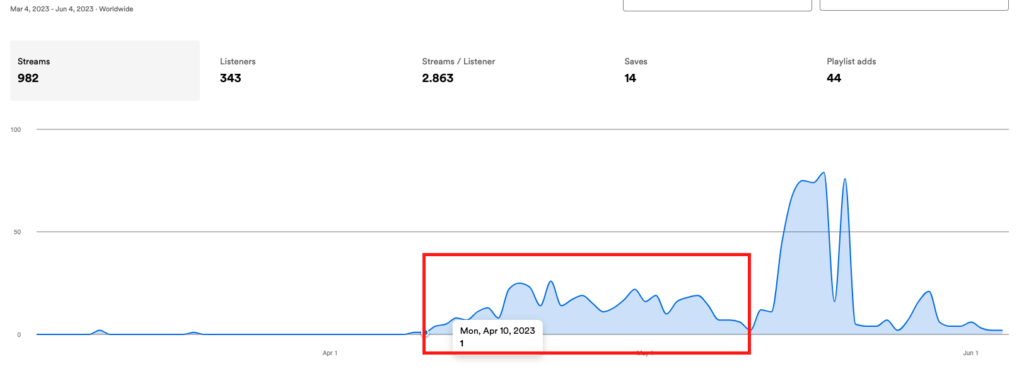
You can read my full review of a previous Groover campaign here.
One note on the experience: In the aftermath of the campaign, the song got auto-added to a playlist by WAVR.AI that appears to be built with bots (that’s that weird spike after the campaign in the image above). This isn’t Groover’s fault; the two companies aren’t affiliated in any way. For what it’s worth, WAVR seems to be a company that scrapes other playlists to catch the attention of artists by boosting their streams. More on them later.
Again, not Groover’s responsibility (I’ve seen DistroKid artists who haven’t used Groover get added to WAVR lists, too) but it’s an annoyance worth noting. Here’s hoping Spotify takes WAVR down soon.
Pros of Groover
- Their submission process is really streamlined. If you’re the kind of person who finds SubmitHub’s filter confusing, you may like Groover’s process better. The control is a little less granular, but it’s a very quick and clean setup.
- There are good curators on the platform – and there are a lot of curators on the platform. (I’m not entirely sure, but in speaking with many of the companies on this list, I think that in terms of the sheer number of curators Groover is likely the largest submission platform in the world.)
Cons of Groover
- As I noted with SubmitHub, these platforms don’t pay curators as much per review, so bigger curators often go elsewhere.
- You don’t have a lot of ability to filter by the genre of your song. While you can still comb through for good playlist fits, this makes it a little harder.
- The curator network leans European, which, of course, shouldn’t technically be a con, but should be food for thought if you’re looking for growth in other geographies.
The bottom line: I’d use Groover if you’re a European-based artist looking for targeted placements or if you’re looking to complement a SubmitHub campaign and reach other curators.
While this isn’t my top option for a high number of streams, this is a growing platform that has a wide variety of curators, and you can get started with a small spend and little risk. If you want to try it, use the code TWOSTORYMELODYVIP to get a 10% discount on credits.
Bonus: Two Free Playlisting Platforms
Let’s wrap up the list with a couple of free options, in case you’re not ready to put down money (which is understandable). Note: While you can get placements with the services below, I’ve been told that many of the lists on free services get few if any streams; I think that it’s probably because, for curators, the incentives for building healthy lists aren’t as strong (and some curators may even be trying to use these platforms as stepping stones to paid networks).
Worth being aware of, but doesn’t mean submission isn’t worth it.
Soundplate
With Soundplate, you submit your tracks to playlists and wait for the playlist curators to give you the big thumbs up or down. It’s worth mentioning that your tracks aren’t guaranteed to land on the playlists to which you submit. If you take the bulk-approach and submit to a bunch of viable playlists, chances are your tracks will safely arrive on at least a few playlists.
But be warned: this service is free, and for a few good reasons. Soundplate doesn’t offer any guidance, support, or consultation if you decide to use their platform. The submission process is also known to be clunky at times. But if you like free stuff, it’s worth a good ole’ college try.
Daily Playlists
Daily Playlists, like Soundplate, is free. Simply add your song’s Spotify URL, manually select the multiple playlists you want to submit to, and follow those playlists to finalize your submissions.
It’s free, painless, and may just result in additional plays, followers, and all-around exposure. Or not.
But again, it’s free.
Companies You Should Probably Avoid
As I mentioned at the top of this article, the sad truth is that there are some total scams out there. As you probably know, a subsection of promo companies rely on bots and click farms to drive streams; in early 2021, those services likely contributed to a bunch of songs being de-listed from Spotify. Be careful. Even worse, there are some pages set up that will take your money and deliver nothing.
Here’s a quick recommendation: Don’t pay for a service until you’ve had communication with that service. Make sure you hear back from a person before you send them your money. (This isn’t always possible, but in my opinion, it’s the ideal.) And with that in mind, I want to offer a few more specific warnings.
These are Spotify promotion companies you should avoid:
Music Diffusion
This company was one of the 15 I tried at the beginning of 2023. Sadly, they were by far the most obvious scam I’ve seen out of any campaign I’ve run so far.
I’ve got a full review of the experience up here, but here’s the summary: The song I tested was placed on five playlists. All of the lists were owned by Music Diffusion, and they all showed signs of bot activity. Worst of all, the streaming data that our placements generated in Spotify for Artists looked totally fake.
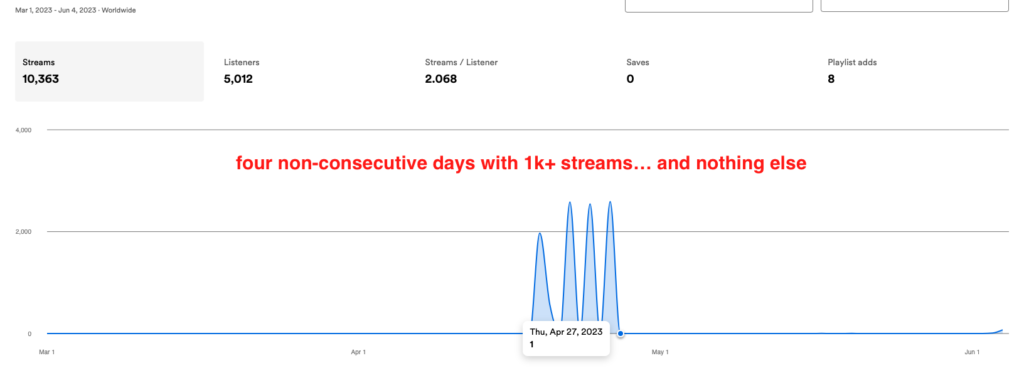
We ended up cancelling the campaign about a week after we started it to try to minimize the damage. I’d recommend you cancel yours right now, before you start.
Musicvertising
This company was also one of the 15 I tried, and they were by far the most confusing.
Long-story-short, the campaign we ran with them resulted in super-suspicious spikes in Spotify followers. Streams didn’t fluctuate all that much, but for a period of about a week, followers jumped up by the exact same number each day. Then a few weeks later, they spiked back down, step by step.
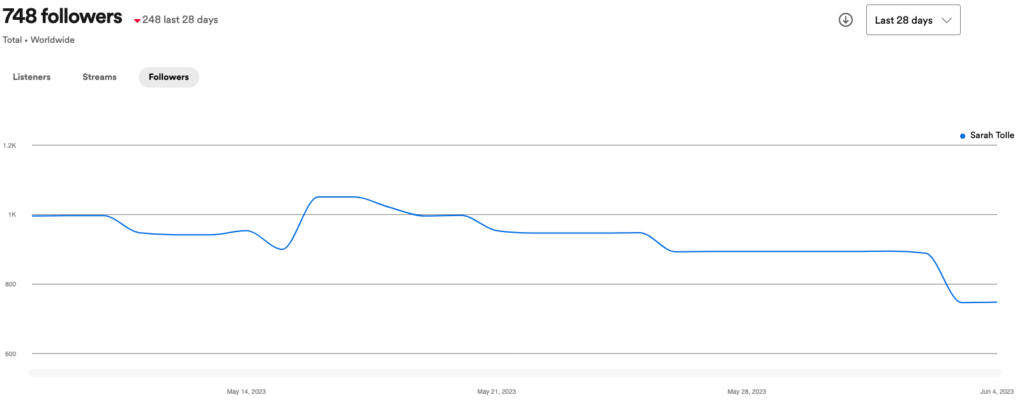
In case you’re wondering, that’s not what normal follower growth looks like.
The streaming data wasn’t as obviously fake as Music Diffusion’s results, so I actually went back and forth with them a little bit to try to figure out what was going on. The rep from the company insinuated that they use Taboola ads to drive traffic to Spotify. I’m not entirely sure, but my guess is that they’re using the broadest geographic target, so that impressions get funneled to countries where the clicks are the cheapest – and usually where the clicks are the cheapest, there are bot farms.
If this what they’re doing, then although they claim that they’re using a legit form of advertising (and I guess it’s possible that they might not be running botted Spotify accounts themselves), the outcome is basically the same.
If it’s not what they’re doing… well, I don’t know what’s going on, but clearly it’s sketchy.
Either way, you should probably steer clear of them.
Artist Push
An earlier version of this article listed Artist Push, but I’ve gotten multiple comments suggesting that they’ve failed to deliver on campaigns (see below in the comments ha). I haven’t had personal experience with this company, but based on what I’ve heard, I’d say proceed with caution – probably get in touch with someone before paying, at least.
Artist Sounds
I’ve only gotten one email criticizing Artist Sounds, but that’s still too much for me to recommend them as a service (and their process looks sketchy, anyway). If you’ve had a similar (or a different and more positive) experience with this company, reach out and let me know.
Orion Promotion
A previous version of this article also listed Orion Promotion as a recommended company (and you’ll still see them in the Canva charts up there). That was based on a real campaign that I ran with them, but unfortunately, in the months since, I’ve had confirmed from multiple sources that this service has become untrustworthy (and often just totally unresponsive).
I won’t get into all of the details here, but the short version is that they’ve been very sketchy in paying their curators, which has snowballed into everything else. Here’s a TrustPilot review that gets into some of it.
Anyway, I’d recommend passing on this company at this time.
The different types of Spotify promotion
Still here? Props. Keep reading, because in this section, I’m going to unpack how the companies I’ve listed above fit into the broad scope of Spotify promotion. I think that’ll be helpful as you consider your options.
As you may or may not know, there are a few different ways to promote music on Spotify. I’d break things down into three categories:
1. Spotify’s Advertising Tools
This type of advertising is probably the safest way to build a presence on Spotify, because you’re using the tools that the platform itself provides for artists. This includes things like:
- Marquee (you pay to show a new release to your own fans when they open the app)
- Showcase (you pay to show a release to users in a featured area on Spotify’s home screen)
- Discovery Mode (you agree to let Spotify keep a bigger percentage of your streaming royalties, they promise to show your music to more people)
- Editorial playlist pitching (you send your music to Spotify’s playlist editors and almost always get rejected, but if you get accepted you get a bunch of streams)
These tools are okay, but in my opinion, they’re kind of limited.
Marquee, for example, won’t put you in front of new ears; it’s just Spotify charging to show you to people who should already be familiar with your music. (I get why they do this, but I don’t love it.) Discovery Mode is… fine. Editorial playlist pitching is like a free lottery ticket; it’s got an awesome ceiling, but it’s nothing you should bank on.
I think that, in general, it’s tough to grow on Spotify if you rely solely on their proprietary marketing tools.
2. Off-Platform Advertising
Another way to grow on Spotify is to use off-platform advertising. As of today, the most common method of doing this is to run Facebook and Instagram ads that send people to your music on Spotify. TikTok and YouTube are alternative platforms for this, but from what I’ve seen, they tend to be less efficient.
I’m a big fan of this type of Spotify promotion. As you may have noticed, it’s the type of promotion I provide at my own agency.
I know that many indie artists aren’t exactly drowning in cash, but if you have the budget, I’d recommend using Facebook and Instagram ads in tandem with playlisting. I think this pairing gives you the best of both worlds. Ads are much more expensive than playlisting at a cost-per-stream level, but their benefit is that they drive highly engaged streams, because users click them with an active interest to hear specific music.
I’d recommend checking out Andrew Southworth’s YouTube channel if you’re interested in learning more about how this approach works. And I guess I’ll also offer this shameless plug: I have a Spotify marketing course that covers both ads and playlists if you want to get going yourself.
3. Spotify Playlisting
And, finally, you’ve got Spotify playlisting, which typically means pitching music to independent playlist curators. This is the primary method used by the companies on the list above.
There are two reasons this method of promotion is so popular:
First, it’s easy to directly impact. While you only get one shot at an editorial playlist pitch per song, you can pitch thousands of independent playlist curators. And if you do pitch a bunch of curators, you’ll almost certainly get something out of it.
Second, playlisting is the most affordable type of Spotify promotion on a cost-per-stream basis, because you don’t have to pay to switch people from one platform to another. Spotify is built for playlists; as a result, it’s pretty common to get tens of thousands of real streams for a few hundred bucks. (For reference, if you spend a couple hundred bucks on a new ad campaign, you’ll be fortunate to break 1,000 streams.)
The downside of playlisting is that it tends to result in the lowest engagement rates. That’s because playlist listeners typically aren’t locked in and actively engaging with every single song; playlists are often used as background music.
So, with that said, is playlist promotion worth it?
Great question. My answer, as it is to so many things, is that it depends on what you’re looking for.
If you want to directly recoup your marketing spend in streaming royalties, then playlisting is definitely not worth it. Don’t expect to make your money back directly on a playlisting spend; if you make a return on investment, it’ll be long-tail over time and myriad channels.
If you want to finally crest the >1,000 streams mark next to a song on Spotify so that random people think you’re more legit, then playlisting definitely is worth it. As I’ve said, it’s the most cost-efficient way to get streams.
If you want to maintain high levels of engagement on your Spotify profile, then playlisting is probably not worth it. Some highly targeted playlists are pretty engaged, but most will dampen your Audience Engagement stats.
If you want to train Spotify’s algorithm on the type of music you make, then playlisting may be worth it – but you’ll need to choose a platform that focuses on high-genre fit playlists rather than using an SEO-focused service.
If you want a bunch of people to hear your music, then playlisting is probably worth it. It’s the most straightforward means toward that end.
The bottom line answer:
Personally, given the budget, I will always run a playlisting campaign and an ad campaign in tandem for every song an artist releases. But if you’re like most of us and have to pick one or the other, think through what you’re prioritizing and choose accordingly.
Spotify promotion service models
If you do decide that you’d like to try Spotify playlist promotion, it’s helpful to know how these companies work. There are a variety of service models that I categorize on the basis of four main factors: 1) Exclusivity of the curator network, 2) type of playlists, 3) pitching method, and 4) what you pay for.
(Oh, and outside of all of these, there’s my own service model, where we build you your own popular playlist. It doesn’t really fit the paradigms below, but it’s still a form of playlisting.)
Read this if you want to know what you’re getting.
1. Exclusivity of the curator network
Open curator networks: These are the companies that allow any playlist curator to apply for inclusion in their network. When you go to one of these companies’ websites, you’ll see a button to apply as a curator or to submit your own playlist.
Companies that have open curator networks tend to have more playlists. However, quality control is harder, and they may struggle to retain big playlists. Campaigns to open networks tend to provide higher-fit placements but fewer streams when compared against closed curator networks.
Closed curator networks: These companies have private relationships with playlist curators; they’ll seek out top curators to join their network, but they have no open application for curators to apply.
Companies that have closed curator networks tend to have fewer playlists. However, they often feature very popular, engaged playlists. Campaigns with these companies tend to provide more streams from less targeted playlists when compared against open curator networks.
Open curator networks
Closed curator networks
2. Type of playlists included on the network
SEO playlists only: These companies only feature playlists that appear in Spotify’s search results. The benefit of this approach is that SEO playlists are virtually guaranteed not to have bots and to drive a lot of streams. The drawback of this approach is that these lists are often broader and less genre-targeted.
SEO playlist focus: These companies lean heavily toward SEO playlists, but may also feature playlists that don’t appear in Spotify’s search results.
Genre playlist focus: These companies lean heavily toward playlists that are genre-targeted, although they may feature a few broad playlists as well. Campaigns with these companies tend to drive fewer streams, but may result in higher engagement rates.
SEO playlists only
SEO playlist focus
Genre playlist focus
3. Pitching method
Done-for-you: These companies take care of the entire pitching process once you submit a campaign. You may provide some information about the genre of your song and your ideal audience, but you won’t pick which curators receive the pitch.
Do-it-yourself: These companies allow you to select the curators you’d like your song to be pitched to. They may have presets available to guide your selection, but you’ll have the final say.
Done-for-you pitching
Do-it-yourself pitching
4. What you pay for
To be pitched to a certain number of curators: You’re paying to reach curators with your music, not for some number of placements. You’ll pay more to send your song to more curators.
Most of the companies using this model don’t guarantee that you’ll receive any placements; however, they won’t cap your campaign at a certain number of placements, either. In other words, this model has a high ceiling but a low floor.
To receive a certain number of placements: You’re paying to be placed on playlists, usually with some guarantee that you’ll reach a threshold of streams or get in front of a total number of playlist followers. You’ll pay more to receive more streams.
Most of the companies that use this model will cap your campaign once you reach the specified number of placements. In other words, you will rarely outperform what you’ve paid for. (This is why I’m slightly cynical about my Playlist-Promotion results – I have a hunch they intentionally overdelivered for me.)
Pay to reach a number of curators
Pay for playlist placements
Interesting things I’ve learned from trying a bunch of Spotify promotion services
Whether you’ve read to this point or you’ve just skimmed down, I’m pleased to announce that this is the final section of this obnoxiously long post.
I’m including this section because a) I learned a lot of random things running a bunch of Spotify campaigns that I think you should know, and b) I couldn’t find an artful way to work this stuff into the post earlier. Sorry.
Here are five random nuggets of information to file away for the next time you try a Spotify promotion.
1. Most Spotify promotion campaigns don’t have a huge long-term impact.
The ideal outcome from a Spotify promotion is that you pay for a short-term bump and then have your reach settle at a new normal, thanks to new fans and algorithmic traction. Here’s what that looks like:

I think of it like stepping up stairs; if you can do this multiple times, you can level up your audience dramatically.
Sadly, this is rarely what happens. Most often, when you run a playlisting campaign, you get a spike, and then things settle back to right around where they were before. Out of the 13 legitimate playlisting campaigns I ran in early 2023…
- 3 provided what I would define as longer-term audience growth
- 10 provided very little long-term audience growth
The moral of the story is that you should expect streams, but you shouldn’t generally expect them to last. Count it as a gift when they do.
2. After a promotion, Radio streams are the first algorithmic bump.
Nearly every legitimate Spotify promotion I’ve ever run has coincided with an increase in Radio streams. Sometimes its a very notable increase; more often, it’s not.
But this is the first algorithmic boost you’ll get, and you should expect to see something from it pretty much any time you run a campaign.
3. Radio streams can come from bots.
Okay, here’s a fact that made me uncomfortable – the most obvious scam promotion I ran (with Music Diffusion) actually resulted in a significant bump in Spotify’s Radio streams.


Botted playlists drove about 9,000 streams for that track; the other ~1,000 of the track’s total streams came from Spotify’s Radio playlists.
I’m not sure how this happened, but my guess is that the bot accounts are set to autoplay through a given list and that they just keep spinning after they go through all of the songs, during which time they rack up streams of “Recommended” songs.
The bottom line: You’d like to think algorithmic plays couldn’t be faked, right? But it looks like Radio streams, at least, can be. (Relatedly, if you want to be safe, you should wear a titanium suit and stay away from everything and everyone.)
4. You should watch out for “scraped” lists.
Another weird thing that reinforces the idea you shouldn’t trust anyone is that, even if you run a completely legitimate promotion, you have the chance of getting added to a scraped playlist that might drive botted streams.
Here’s how it works: Some companies scrape other playlists for songs, then add them to their own playlists in the hopes of catching indie artists as clients. The idea is that if you, as an artist, see your song getting streams from a random playlist, you’ll click through to check it out – and when you see that the curator offers promotional services, you might be inspired to pony up cash for more plays.
(DistroKid’s Wheel of Playlist often gets scraped, for example, because companies know that indie artists who use the platform are looking for ways to get traction.)
This happened most notably during the campaign I ran on Groover. Our track was added to a bunch of legitimate playlists. Then, shortly after the Groover campaign closed, we started getting a chunk of streams from a mysterious list called WAVR.AI.

This is weird in a lot of different ways – for one thing, the playlist has over 1,900 songs on it, so it’s not like it’s curated in any meaningful sense of the word. And then the whole AI thing is strange; if you click through to the company’s website (listed in the playlist description), you’ll see that they claim to offer Spotify promotion through AI tech-based playlisting in small businesses. I don’t really know what that means (but then again, I’m not a computer scientist or a doctor).
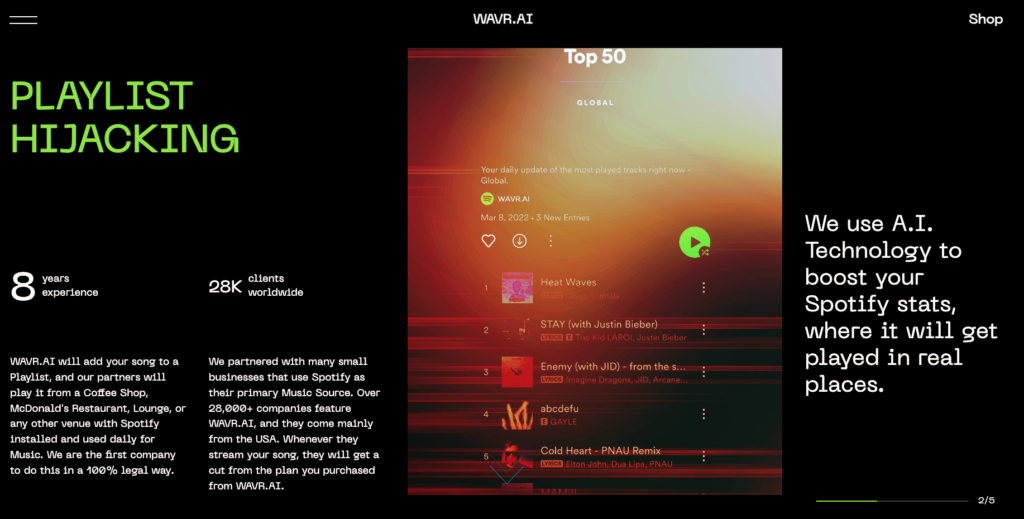
But the most troubling thing is that the playlist has seen drops in followers over the past few months. Here’s a red-flag-level dip in early May, for example:
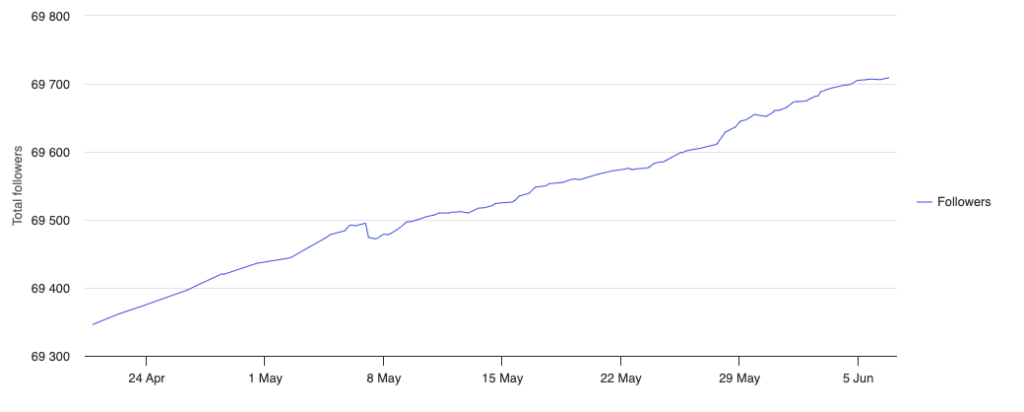
It’s not huge, so maybe that dip wasn’t due to bots; I don’t know for sure. But it’s certainly not good, either.
WAVR.AI isn’t the only company I’ve seen doing this; there are others taking some variation of this same approach. Unfortunately, as an artist, there isn’t much you can do to avoid it. While it does seem that playlisting increases your odds of getting added to something like this, I’ve also seen artists who haven’t run playlisting campaigns end up on WAVR.AI, too. And when you report one of these lists to Spotify, they’ll usually respond by saying that they can’t mess with users’ personal accounts.
So there’s no takeaway for this one; mostly it’s just a little informational nugget to file away as you build your doomsday shelter and hide from the world.
5. Playlists can grow the streams from “Listeners’ own playlists and library.”
Let’s end on a more encouraging note: It’s not all about the algorithm.
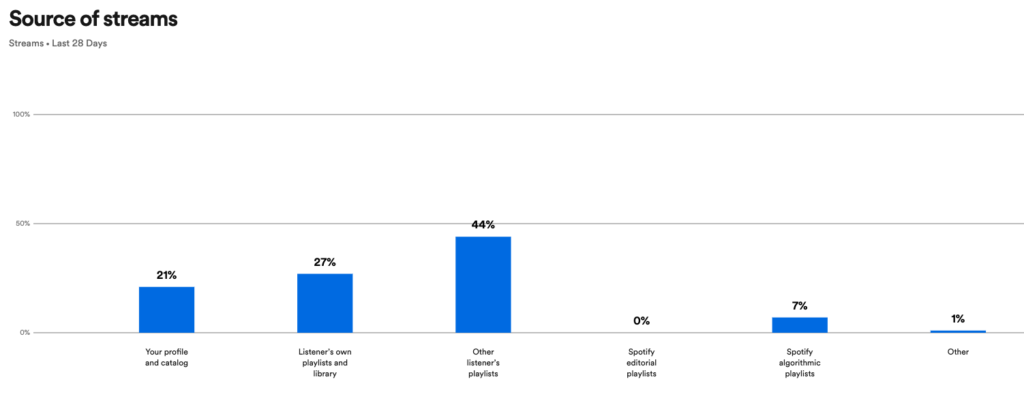
⬆️ That’s the data from a song for which I ran a playlisting campaign earlier this year. You’ll notice that there was hardly anything of an algorithmic bump (7% is kind of brutal), but you’ll also see that a sizable chunk of streams are coming from “Listeners’ own playlists and libraries.”
We marketers like to make a big fuss about getting algorithmic traction. And while it’s true that getting an algorithmic bump is good news, because it’s a sign that Spotify likes you, it’s also true that finding living, breathing fans is good news, too.
Playlisting isn’t as highly targeted as direct ads, but when you get on a good list, you can find people who will take a real interest in your music. I’ve seen it happen multiple times.
And it’s pretty awesome.
Final thoughts on Spotify promotion services
If you’ve read this far, congratulations – you’re either incredibly dedicated to getting your music heard or you have too much time on your hands. Maybe both. Regardless, I appreciate you, and I hope the information above is helpful as you consider Spotify promotion for your own music.
Two final things:
First, as means of a brief recap, here’s my list of top companies again.
- Members Media
- Indie Music Academy
- YouGrow Promo
- Two Story Media
- Playlist Push
- Moonstrive Media
- Daimoon Media
- Omari MC
- Playlist-Promotion
- SubmitHub
- Spin Promo
- SoundCampaign
- SubmitLink
- Groover
Second (and last!), I’d love to hear your thoughts on this stuff. Leave a comment below and let me know if you’ve had a notable experience (good or bad) with a company on this list. And let me know if there’s a service I should check out that’s not listed here. I’ll check back and try to keep this post decently up to date because I think this stuff is important – because I think music matters.
As you navigate the confusing world of Spotify promotion, here’s hoping you don’t lose sight of that.
And, as always, here’s wishing you good luck.








60 Responses
Thank you great information
Thank you, we were trying to sort out spotify and this helped.
I find it funny that you claim Playlist Push and Indie Music Academy are legit, meanwhile Indie Music Academy specifically points to Playlist Push being no good/bot streams.
Hey Andrew, where have you heard Ryan say Playlist Push uses bot streams? On his landing page he writes Playlist Push and SubmitHub “fall short”, but that’s a long way from saying the streams aren’t real. In my experience, they are.
Based on campaigns I’ve run, their playlist curator network is legitimate, but their submission process is really automated, so there’s a good bit of variance to the results. Wouldn’t be surprised if he ran a disappointing campaign, but I would be surprised if he got bot streams from them.
Thanks for all this info.
Lost of these look really great – your top 5 in particular.
Indiefy, Online Music Promotion, Songlifty and Artist Push look dodgy to me. Literally using the language “buy plays”. I’d avoid these.
Yeah, fair call! Definitely dig into the service (and ideally communicate expectations with the owner) for yourself before putting money in.
Any chance you can look into Imperium and Hearken Wave?
Hadn’t heard of either one – I’ll definitely make a note to check them out.
Thanks Jon, this helped me a lot to finde the best spotify promotion service for my niche!
Thanks for this list. Been seeking reputable services and have tried Playlist Push in the past with some success. Their prices skyrocketed, so I haven’t used in over a year.
I just ran campaigns through 9 and 11 on your list (Artist Push and Online Music Promotion). They’re still in motion, but based on early returns, I highly recommend OMP and discourage anyone from hiring Artist Push.
Why? OMP has delivered close to 1100 streams in 48 hours, from close to 1100 people. AP has delivered about the same number of streams….all from less than 50 listeners. Really hoping Spotify doesn’t flag my account for that one. It looks suspicious to me, so it will to them.
Thanks for sharing, Aronim. I’m going to note that in the article.
Thanks for making a list. It would be better if you also talked about the pricing. For example playlist-promotion.com doesn’t list their price on their site. Your review would be more interesting adding these notes. Most prices seam to start around $250. That might be too much for someone who wants to start testing these services. I found omarimc.com rather rude. It looks like he wants people to serve him. It is confusing with him selling his own coins. Surreal. The price is 77$ for 500 plays which is too much.
Fair point on pricing – I’ll make a note to add that in soon.
Yeah, Omari got into the crypto scene last year. I kind of agree that the push for paying in crypto is a little disconcerting (I find the sales page a little distracting). But he’s betting it’ll pay off over the next few years. Definitely on the cutting edge.
Here is another one that I found but still haven’t used. It costs 65$ and has good 50+ reviews on trustpilot https://artistrack.com/spotify-playlist-promotion/ Any opinions on them?
Hey Dario, haven’t heard of them (there are so many companies in this space), but open to trying them out and seeing what results are like.
Do you cheking this?
Not yet. Still planning to, but probably won’t be till 2024.
I just wanted to ask folks if they had any experience with Musicvertising.com? I’ve used them for 3 months. The results seemed very promising. 25k stream, 120 playlist adds, 3K plus followers. Once I receive my royalty data from CDBaby who do my distribution and collection I saw that I was being paid zero for all the plays. How come? Surely some of the plays would be legit. I’m waiting to hear back from them to see what they say. Do I ask Spotify about this? Any help much appreciated. Markus from Tenderhooks
No, I haven’t used them. Streaming thing is weird, but it could be on CD Baby’s end.
I’d try plugging the playlists they placed you on into Chartmetric and seeing if the lists had any weird follower spikes. A sharp dip in followers, IMO, is the #1 sign that a playlist is botted – it’s basically Spotify removing a bunch of accounts at once.
So, what Musicvertising.com said?
I consider Musicvertising.com and your review is useful.
I’m actually going to try musicvertising.com in the next month or two, and I’ll be updating the post based on the results.
I’ve used Submit hub a few times and I have to agree that yes, your song will get heard by real people and they will respond to you since they are required to do so. But don’t expect anything more than just getting feedback from a non-musician about what they did or (in most likely cases) didn’t like about your song. These people are mostly bloggers- despite calling themselves “Labels” or “Magazines”, and they have their own little fiefdoms that they are proud of. And definitely don’t think that because someone says your song doesn’t have a strong enough hook or compelling lyrics, that you should take it as serious critical critique. Before submitting to anyone, try and find their website or social media pages first, and see what they are actually up to and if their own numbers are actually legit. Submit HUB is pretty cheap, but for my money, it’s not cheap enough for what you get in return.
Oh man, definitely agree on the fact that you shouldn’t take SubmitHub feedback as worth anything. It’s not worth anything. (And I’m on SubmitHub as a curator ha.)
As far as whether or not SH is worth it – I’ve had a really wide range of results. Had a campaign the other month that got 30k+ streams for like $20; we got on an alexrainbird playlist and it was great. I’ve had plenty of other campaigns where I’ve paid $100 and gotten virtually nothing. Definitely hit or miss.
I discovered SongLifty in this list, and I’m quite surprised you took them out… I’ve been using it for over a year on my new releases, and results have been fantastic. Customer support is great, and I even get pushed by Spotify’s Algorithmic Playlists every time I order.
Yeah, we had them on there for awhile, but I had multiple people reaching out to say they weren’t getting good results. I’d be up for revisiting them in the future, though. One thing we’re learning is that this field is hugely variable – results / companies are changing all the time.
Thanks, Jon . . . I appreciate the insight and recommendations. Will save me a lot of time in trying to figure this out myself! One question – is there overlap between these services as to the playlists they approach? Is it worth sending the same song to two or three of these services, or will the costs and efforts be redundant?
Hey Ron! Yeah, there definitely is some overlap. I’d say, if you’re going to run campaigns with multiple companies, ask to see which playlists you’ll be pitched to. If the same playlists turn up multiple times, pick the company you feel best about. It’s probably not worth it to pay to double-pitch.
Hi John,
I used your research and tried out some of the services listed. Indie Music Academy is legit, however they couldn’t help me with my style of music (RnB/Pop), but I was refunded in full. YouGrow Promo is legit and was able to playlist one of my songs, but the other didn’t make it and they refunded me promptly. I started with the lowest plan just to try it out and the playlist they put me on was really good. I got quiet a bit of streams, some saves and playlist adds. I also tried out their YouTube promo, but I wasn’t as impressed with that and I would say for me stick with the Spotify promo. Further down the list I tried Artist Push and I highly recommend you remove them from this article. I paid for a Spotify playlist placement. They delivered…but, it was completely BOTTED traffic. I got 2000 plays only from one person in Finland! Then I looked at the person’s profile that owned that playlist and it was full of bots. It caused my “other” category to spike really high also. I asked them twice to remove my song, they refused and gave me the runaround. Of course they refused to give me my money back also. So please do not recommend them at all. Burstimo seemed cool but out of my price range (around 5k). I haven’t tried anyone else, but that’s my take on these playlisters. I think I will stick with YouGrow promo and my fb/ig ads to continue my growth. I appreciate this article though. Wanted to show others who is good and who to avoid.
Thanks, Nycole! Updating the post with that info.
Jon, what can you tell us about Playlist Radar? Thank you!
Not a bad option for finding curators yourself! I’d consider them a tool more than a service, though. I actually wrote a post on this: https://twostorymelody.com/find-spotify-playlist-curator-tools/
I’m not sure about all reviews. I tried a lot and I can day a few of them deliver bots only.
I will keep the respect for everybody not to call out names. But 5 of the names on this website are not Legit.
Others I am using as well + I’m using the Spotify pitch services of HB Agency.
They are in the game since 2010 and do also work for major artists and labels and are very open in results.
I found them dedicated Legit and Organic in results.
For me one of the best to work with and affordable offers.
Hey Fiso, feel free to share the companies you think provide bots. I’ve tried all of these services personally, which is why they’re on the list. But I know things can change quickly in the Spotify world.
Where is Partnered Projects? I thought they were like the go-to for playlist promo. We’ve been using them a long time now. Are we the only ones who knows about this hidden gem? lol
I’m actually about to add them ha. Just tried a campaign with them for the first time and was really impressed.
Some of these won’t allow you submit “Explicit” songs. I just don’t exactly know where the line between clean and explicit is. If my song uses the word “Damn” once and talks briefly about “drinking hard”, is that considered explicit?
I think if all you’re just saying “damn” and referencing “drinking hard,” you’re probably okay. Google “Parental Advisory Standards” – it’s kind of blurry, but basically, you get to determine if your song is explicit or not.
As far as playlisting, I’d just try submitting to the company you’d most like to work with – they can determine if it meets their standards or not.
Hello. Do you have feedback on the company ‘Spotify Expert’? Thanks
No, sorry – just looked them up, but hadn’t heard of them till now. I’ll mark them down to check out.
Thank you for the highly informative articles.
As a regular user of Groover and SubmutHub, I recommend these over the other options listed. Yes, you will get rejected (more often than you will be accepted) and the truth is that this is a microcosm of music consumer behavior in general—some people will love you, but the sad truth is that many will not, whether it be a bad fit for their playlist’s vibe or something as blunt as them hating the sound of your voice. In the end, however, you are getting real feedback from real people who have listened to your song and made a decision. And, when you DO get a placement, you can truly celebrate having endured the process of putting yourself out there and finding honest-to-God interest in your music. We may be talking only 10 or 20 extra streams (usually a lot more from a good curator), but those are real, engaged listeners most of the time, and in many cases the curator will share contact info through those platforms, so there is greater potential to build relationships in the business.
On the other hand, I would STRONGLY DISCOURAGE any fellow artists out there from employing any of the services Jon has listed under “Pay for Playlist Placements” – for one, it’s arguably against Spotify’s terms, and you always risk damaging your data or worse, your reputation as an artist. Sadly, I have fallen for payola placements in the past, and I have regretted it every time. You wind up on giant lists with little (in some cases no) relevance to your sound, you get unbelievable spikes in listeners (literally hundreds at a time) followed by several hours of nothing. They can claim “organic” all they want; the moment anyone is accepting money in exchange for playlist placement, then any notion of “curation” is nonsense and those streams become meaningless. You will be, as the article notes, right back where you started when the promotional period is over.
Thanks for reading, and appreciate the perspective, Travis!
Yeah, Spotify’s User Guidelines do state that you shouldn’t “accept any compensation to influence the content included on an account or playlist.” (Here’s the link for anyone who’s interested – it’s point 7: https://www.spotify.com/us/legal/user-guidelines/)
That said, I think the guys at Indie Music Academy or YouGrow, for example, would argue that they’re doing essentially what SubmitHub is doing: paying to pitch music to curators rather than paying for specific placements. It’s definitely muddy water, though.
I’d also say that, while I’ve seen some campaigns from “Pay for Placements” companies that have generated poor-fit placements and no long-term results, I’ve also seen campaigns from these companies drive long-term growth really effectively. Check out the YouGrow campaign data from this article, for example, and it’s hard to argue that it was a short-term spike from poor-fit lists.
In general, though, I agree – SubmitHub and Groover are safer and give you a better shot at building relationships with curators.
Really great article that explains a lot besides what you might get for your money.
A recent article in BMI’s artist newsletter highlights a company called Rise (Terris Meisenheimer is CEO).
As an indie folk artist about to release my 2nd album in 25 years I don’t expect to get millions of listeners or tons of mainstream play, but I’m doing as much research as I can to see what kind of promotion makes sense. Your article gives me the impression that at an average $0.0033/stream payment on Spotify, playlist promotion is essentially a vanity affair: you’d need about 30,000 streams to make $100, and none of these services come even close to the break-even point. But other streaming services pay more, so does it make more sense to promote your music elsewhere? Or do the others just have a lot fewer listeners so it amounts to the same thing?
Thanks for reading, Tony.
I don’t think you’re going to find a streaming platform where you can pay for promotion and get an immediately positive ROI from streaming revenue – Spotify pays pennies, but it’s not like Deezer or Amazon or whatever is all that much better.
Like you said, to some degree streams are just a vanity metric. But I’d also view streaming promotion as a long-term investment; for it to be financially viable, you have to find a way to turn streamers into fans / customers. That takes some doing (and Spotify doesn’t make it particularly easy), but it is possible.
I wrote more about monetizing your audience here: https://twostorymelody.com/how-do-musicians-make-money/ (Spoiler: Touring / live performances are the easiest lever.)
Thank youuu so much for your article. It helped and still helping a lot. I am an independent artist and I have a new single that is about to be released (in app 1 week and something). I was so crazy looking around ways to promote it and found you. I am still not sure which way I go but at least have some kind of context. A question: does it worth if I do it in YouGrow and Groove at the same time?
Once again, thank you for what your are doing, it’s too much information around that sometimes we do not know which ones are legit and which one not and the difference between them. You just summarize them all. Thank you
You definitely could use YouGrow and Groover at the same time… some of these services do have some curator overlap, but I think those two have networks that are relatively separate.
That said, I’d probably recommend that instead of paying for two playlisting services at once, you try one playlisting service in tandem with Facebook ads. Using both methods will keep your audience engagement levels decent while also giving you cost-efficient streams.
Just wanted to say Thank You for all the hard work you put into this. I read the two e-mails on that topic first and now the more in-depth blog article and the even more in-depth articles on the respective services. I appreciate all those hours and hours of research and work in order to cover such a hot and serious topic for us musicians! Thank you, Sir!
Not going to lie, it was a lot of work haha. Appreciate you reading, Jannis!
Great research, thank you for your solid and fair insights!
Hello,
Great article. My experience Indie Music Academy ( pricey a bit) but delivered decently..one track about 13,000 views but once time was up ( maybe a month) views dropped like a rock. Huge fan of the ease and fun interactivity of Groover..reasonably priced..excellent pro interaction. I did get on many playlists through Groover..even positioned first or top 10 on some. My overall listener #’s however didn’t rise particularly well correspondent to my playlists numbers or position…that was disappointing tbh
Yeah, Groover is solid. I don’t think their playlists are quite as big / engaged as some of the other companies here, but the user experience is great. Thanks for sharing.
Thanks for the great read Jon, yesterday l spent $250 with Soundcampaign think it was a Spotify service. Today l know a lot more. Did l totally waste my money.
SoundCampaign isn’t in my top tier, but I do think they’re legit. Hope the results were okay!
Hi,
Very helpful article. Many thanks for that.
We have been approached by RepostNG and paid for a one track listing for as month for USD89.
That has gotten us over 100K streams, so it was well worth it.
I am not sure still if all is legit so do you have any more info about them? Thanks.
They’re on my radar. Tbh I’m kind of sketched out by them, because I think it’s weird that they approach artists… and I’ve seen a bunch of tracks added to their playlists without any kind of contact. Just seems a little strange, but I’m planning to dig a little more.
We tried Orion after reading about them here, they got us on a bunch of dead playlists that brought in zero plays. Their customer service was terrible. Total waste of time and money.
Thanks for sharing, Bryan, and sorry to hear that. I do think they’re legit (in that they don’t use botted playlists, as far as I can tell), but I also don’t think they’re on the same tier as some of the companies I’ve got listed higher here.
Hi Jon. I was just curious if you’ve had any experience with Pitch-Us.com. They claim to be able to significantly boost algorithmic growth through affiliate ads. They’ve got pretty good reviews but I haven’t found enough evidence to convince myself that they’re legit yet. Thanks.
I haven’t heard of them. I’ll add them to the list to check out, though – thanks for the heads-up.
Hey Jon,
After reading your article I went with YouGrow but for their Instagram package and they got my song posted by three “Influencers” who added no caption to the post highlighting my song and whose comment section were filled with bots. I am speaking with Customer Service now about this and they say they have a zero tolerance for bots but if thats the case then they have poor quality control. This experience has me feeling that I won’t use them for their Spotify promotion and will instead try partneredprojects and also look into Rise which I saw posted in the comments section.
Also, I tried submit hub and received some of the most nonsensical responses as to why my song was turned down… “I like your song but, I don’t know how to explain it, its a no” like what? haha
Yeah, YouGrow’s influencer stuff is… okay. I actually made a video about it here: https://youtu.be/LqjAF6kehrg?si=m7hYA0Km1bAtq6jV
TL;DR is that I had kind of a similar experience to you. I’m not going to blame YouGrow for bots commenting on IG accounts (I mean, bots comment on my personal IG posts, and I have like 200 total followers ha), but I did come to the conclusion that influencer marketing in the manner they’re doing it is just kind of useless.
And as far as SubmitHub – yeah, that’s par for the course there ha. Curators see so many submissions that they’re just looking for things to say (and most of them aren’t musicians in the first place, so it’s not like their feedback would be great, anyway). I think the platform as a whole is great, but I pretty much ignore the feedback.